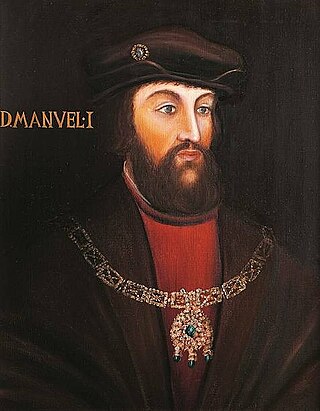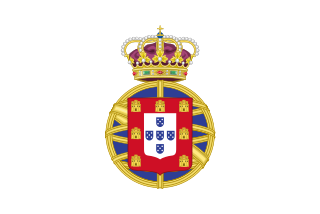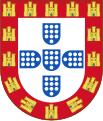
Afonso III, or Affonso, Alfonso or Alphonso (Portuguese-Galician) or Alphonsus (Latin), the Boulonnais, King of Portugal was the first to use the title King of Portugal and the Algarve, from 1249. He was the second son of King Afonso II of Portugal and his wife, Urraca of Castile; he succeeded his brother, King Sancho II of Portugal, who died on 4 January 1248.

Manuel I, known as the Fortunate, was King of Portugal from 1495 to 1521. A member of the House of Aviz, Manuel was Duke of Beja and Viseu prior to succeeding his cousin, John II of Portugal, as monarch. Manuel ruled over a period of intensive expansion of the Portuguese Empire owing to the numerous Portuguese discoveries made during his reign. His sponsorship of Vasco da Gama led to the Portuguese discovery of the sea route to India in 1498, resulting in the creation of the Portuguese India Armadas, which guaranteed Portugal's monopoly on the spice trade. Manuel began the Portuguese colonization of the Americas and Portuguese India, and oversaw the establishment of a vast trade empire across Africa and Asia.

The title Duke of Braganza in the House of Braganza is one of the most important titles in the peerage of Portugal. Starting in 1640, when the House of Braganza acceded to the throne of Portugal, the male heir of the Portuguese Crown were known as Duke of Braganza, along with their style Prince of Beira or Prince of Brazil. The tradition of the heir to the throne being titled Duke of Braganza was revived by various pretenders after the establishment of the Portuguese Republic on 5 October 1910 to signify their claims to the throne.

The flag of Portugal is the national flag of the Portuguese Republic. It is a rectangular bicolour with a field divided into green on the hoist, and red on the fly. The lesser version of the national coat of arms of Portugal is centered over the colour boundary at equal distance from the upper and lower edges. Its presentation was done on 1 December 1910, after the downfall of the constitutional monarchy on 5 October 1910. However, it was only on 30 June 1911, that the official decree approving this flag as the official flag was published. This new national flag for the First Portuguese Republic, was selected by a special commission whose members included Columbano Bordalo Pinheiro, João Chagas and Abel Botelho. The conjugation of the new field color, especially the use of green, was not traditional in the Portuguese national flag's composition and represented a radical republican-inspired change that broke the bond with the former monarchical flag. Since a failed republican insurrection on 31 January 1891, red and green had been established as the colours of the Portuguese Republican Party and its associated movements, whose political prominence kept growing until it reached a culmination period following the Republican revolution of 5 October 1910. In the ensuing decades, these colours were popularly propagandised as representing the hope of the nation (green) and the blood of those who died defending it (red), to endow them with a more patriotic and dignified, therefore less political, sentiment.

The Most Serene House of Braganza, also known as the Brigantine dynasty, is a dynasty of emperors, kings, princes, and dukes of Portuguese origin which reigned in Europe and the Americas.

The Kingdom of the Algarve, after 1471, Kingdom of the Algarves, was a nominal kingdom within the Kingdom of Portugal, located in the southernmost region of continental Portugal, until the end of the monarchy in 1910.

The Iberian Union is a historiographical term used to describe the dynastic union of the Monarchy of Spain, which in turn was itself a dynastic union of the crowns of Castile and Aragon, and the Kingdom of Portugal, and of their respective colonial empires, that existed between 1580 and 1640 and brought the entire Iberian Peninsula except Andorra, as well as Portuguese and Spanish overseas possessions, under the Spanish Habsburg monarchs Philip II, Philip III, and Philip IV. The union began after the Portuguese crisis of succession and the ensuing War of the Portuguese Succession, and lasted until the Portuguese Restoration War, during which the House of Braganza was established as Portugal's new ruling dynasty with the acclamation of John IV as the new King of Portugal.

The Philippine dynasty, also known as the House of Habsburg in Portugal, was the third royal house of Portugal. It was named after the three Habsburg Spanish kings, all named Philip, who ruled Portugal between 1581 and 1640 under the Iberian Union, a dynastic union of the crowns of Spain and Portugal. The dynasty's kings were Philip I, Philip II and Philip III.

Ruide Pina (1440–1522) was a Portuguese chronicler.

The coat of arms of Portugal is the main heraldic insignia of Portugal. The present model was officially adopted on 30 June 1911, along with the present model of the Flag of Portugal. It is based on the coat of arms used by the Kingdom of Portugal since the Middle Ages. The coat of arms of Portugal is popularly referred as the Quinas.

The United Kingdom of Portugal, Brazil and the Algarves was a pluricontinental monarchy formed by the elevation of the Portuguese colony named State of Brazil to the status of a kingdom and by the simultaneous union of that Kingdom of Brazil with the Kingdom of Portugal and the Kingdom of the Algarves, constituting a single state consisting of three kingdoms.

Portuguese heraldry encompasses the modern and historic traditions of heraldry in Portugal and the Portuguese Empire. Portuguese heraldry is part of the larger Iberian tradition of heraldry, one of the major schools of heraldic tradition, and grants coats of arms to individuals, cities, Portuguese colonies, and other institutions. Heraldry has been practiced in Portugal at least since the 12th century, however it only became standardized and popularized in the 16th century, during the reign of King Manuel I of Portugal, who created the first heraldic ordinances in the country. Like in other Iberian heraldic traditions, the use of quartering and augmentations of honor is highly representative of Portuguese heraldry, but unlike in any other Iberian traditions, the use of heraldic crests is highly popular.

The Military Order of Saint James of the Sword is a Portuguese order of chivalry. Its full name is the Ancient, Most Noble and Enlightened Military Order of Saint James of the Sword, of the Scientific, Literary and Artistic Merit.

The Liberal Revolution of 1820 was a Portuguese political revolution that erupted in 1820. It began with a military insurrection in the city of Porto, in northern Portugal, that quickly and peacefully spread to the rest of the country. The Revolution resulted in the return in 1821 of the Portuguese court to Portugal from Brazil, where it had fled during the Peninsular War, and initiated a constitutional period in which the 1822 Constitution was ratified and implemented. The movement's liberal ideas had an important influence on Portuguese society and political organization in the nineteenth century.
In the Medieval Kingdom of Portugal, the Cortes was an assembly of representatives of the estates of the realm – the nobility, clergy and bourgeoisie. It was called and dismissed by the King of Portugal at will, at a place of his choosing. Cortes which brought all three estates together are sometimes distinguished as Cortes-Gerais, in contrast to smaller assemblies which brought only one or two estates, to negotiate a specific point relevant only to them.

The Mantle of João VI, also known as the Mantle of the United Kingdom of Portugal, Brazil, and the Algarves, is the royal robe, a part of the Portuguese Crown Jewels, that was fashioned for the acclamation of King João VI, alongside the Crown of João VI and the Sceptre of the Armillary.

The Monarchy of the North, officially the Kingdom of Portugal, was a short-lived revolution against the First Portuguese Republic and a monarchist government that occurred in Northern Portugal in early 1919. It was based in Porto and lasted from 19 January to 13 February 1919. The movement is also known by the derogatory term Kingdom of Traulitânia.

The Kingdom of Portugal was established from the county of Portugal in the 1130s, ruled by the Portuguese House of Burgundy. During most of the 12th and 13th centuries, its history is chiefly that of the gradual reconquest of territory from the various Muslim principalities (taifas) of the period.

The Castle of Almada is a medieval castle located in the civil parish of Almada, Cova da Piedade, Pragal e Cacilhas, in the municipality of Almada, Portuguese Setúbal.

































